




I have a strong, preexisting bias against the Toyota Prius, not necessarily for the “greenie” mindset often held by its smug owners or the insect-like styling. I can certainly love an ugly car if it aims to please, the BMW 1-series being the strongest example.
No, it’s because the Prius stands as an example of a stark future where motoring is a chore rather than a joy and the driver is the equivalent of an office worker operating a computer mouse. The automobile then becomes a rolling cubicle — soulless, joyless, and indistinguishable.
Yesterday, my friend asked if I wanted to tag along for a 350-mile trip to Chicago. He recently became an avid collector of Bang and Olufsen audio equipment and found some deals on Craigslist. Between my Saab’s limited cargo space (and ailing 22 year old automatic transmission) and his 15-mpg Escalade, the solution was a rental car.
For $18/day, Avis promised him a standard vehicle similar to the Ford Fusion. When he arrived at the airport counter they had none left and asked if he’d be interested in a Prius. For fuel cost reasons, he accepted the offer. Personally, I would have asked for a Dodge Dart, Ford Focus, Chevy Sonic, Chevy Cruze, or Dodge Avenger — anything but a Prius. The Nissan Altima, for whatever reason, had an upcharge.
Here’s realistic a breakdown of fuel costs for St Louis to Chicago round trip, taking $4.29 regular unleaded (screw Illinois taxes) and 700 miles into account:
My 1991 Saab 900 turbo automatic — 21mpg premium — $150
His 2008 Cadillac Escalade — 15 mpg regular — $200
2012 Dodge Avenger 2.4 — 28 mpg regular — $107
2011 Ford Fusion 2.5 — 28 mpg regular — $107
2012 Toyota Prius — 45 mpg regular — $67
As you can see, the Prius saves $127 over taking his Escalade and $77 over taking my Saab. Unfortunately, only $34 is saved over taking a Ford Fusion, a significantly more comfortable car with a better sound system, superior handling, and better high-speed stability. That’s a lot to sacrifice for a measly $40 (divided by two people!).
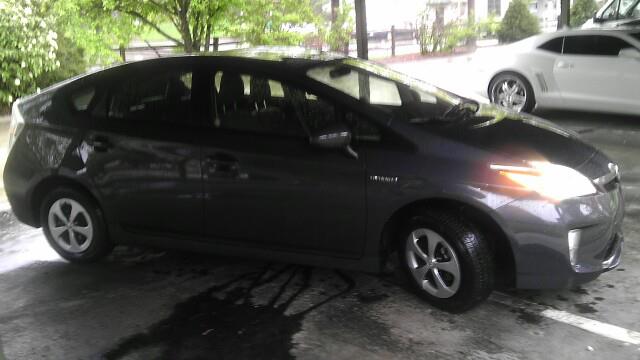
Even though this trip would have cost me next to nothing, I strongly considered staying home upon seeing the Prius. Chicago’s appeal, for me at least, is the vast selection of hearty Polish, German, and Italian-influenced foods, especially the hard-to-duplicate Italian beef sandwich.
Conceived nearly a century ago as a portable, cheap, paper-wrapped lunch for working men in the city, the beef sandwich is a dense, thick loaf with peppers and slow-cooked beef piled high. The thinly sliced beef spends the day simmering in its own juices, heavily seasoned and spiced with hot or sweet peppers on top. I order mine extra wet which means the whole sandwich, bread and all, is grabbed with tongs and dunked into the au jus. Done properly, the end result is so wet and gloppy it has to be eaten with a fork.

I have been unable to find a proper Italian beef outside of Chicago. The “Chicago-style” eateries here in St Louis under season their beef and lightly spoon the juices over the sandwich rather than dunking the whole thing. Worse, they serve it by default with cheese! The result is a characterless lump of beef on a piece of dry bread, the kind of sandwich a Prius owner might enjoy.
Admittedly, it’s ugly. It looks like someone picked pieces of fallen roast beef off a wet kitchen floor and threw it on a roll, but anyone who eats exclusively with their eyes is a miserable jackass. Some of the world’s most pleasing dishes can take on the appearance of dumpster slurry — look at chili, for example, which looks like diarrhea. The Hawaiian squid dish pictured below looks like vomit, but the taste and texture are similar to a curry:

Perhaps Americans deserve nothing but bland, fried food.
The point is, the taste of the Chicago Italian beef sandwich is so appealing (I’ve taken food-inspired train trips before), I thought I’d be willing to endure 10 hours in a Prius.
But I was very wrong.
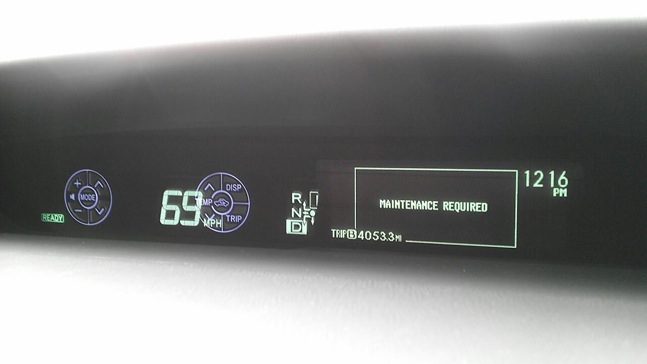
Inside the third-generation Prius, the driver is greeted with a display that looks similar to what you may find on a high-end kitchen oven. When you run your fingers over the steering wheel buttons, they pop up on the screen to help guide your fingers.
“READY” is continuously displayed in the lower left, like a command prompt from a Commodore 64. What it means or indicates is beyond me.
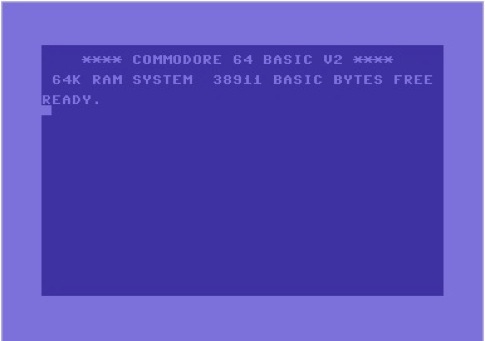
Below are two thin vents and a consumption display that can be switched to show radio or call information. Unfortunately, text is a bit blurry due to the LCD’s poor resolution. Brightness and contrast are lacking as well.
Audio quality from the Denso head unit and factory speakers is nothing remarkable and there were some Bluetooth dropout issues with the iPhone 5. The base audio systems in the Rav 4 and Camry are vastly superior, though this is a noticeable step up from the Corolla.
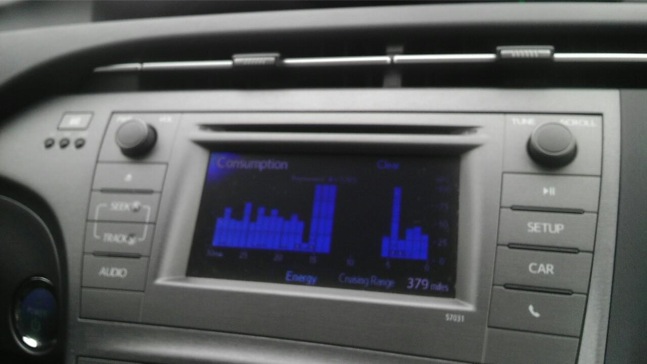
As a friend of mine commented on Facebook, “The last thing I want to do when I’m driving is stare at a bar graph.”
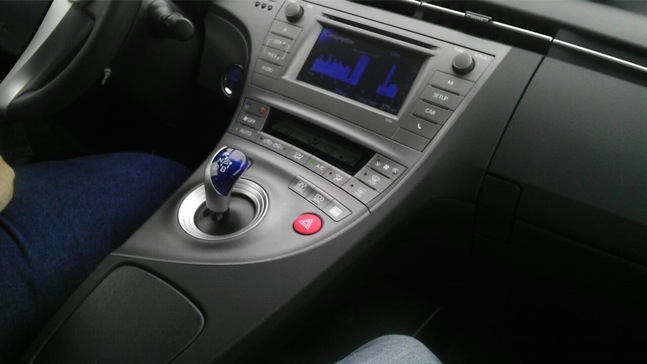
Near the bottom is an automatic climate control display with a green backlight [that doesn’t match anything else in the interior] and an electronic shift nub with R, N, D, B, and a separate button to the upper left for Park. “B” mode is an engine braking simulator that allows the Prius to coast down steep inclines without cooking the brakes.
The air conditioning was pathetic, just enough to defog the windows but not enough to make the cabin comfortable. It was nice, however, to keep the AC on while napping at a rest area. In Park, the engine comes on only as needed to keep the battery charged, functioning as a generator, allowing the car to mostly sit in silence while we dozed off.
The dashboard is long, reminiscent of a Dodge Intrepid, and passenger space is quite reasonable for a small car. There’s plenty of head room, generous rear leg room, and plenty of cargo space behind the rear hatch. Unfortunately, there’s little width for the front passenger’s knees. I found myself uncomfortably resting my legs against the hard and intrusive center console and passenger door arm rest.
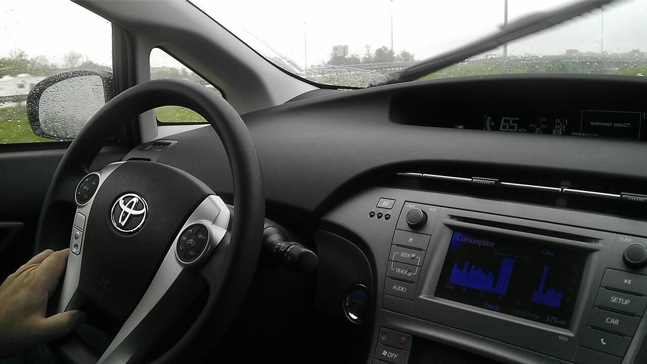
The awkwardly shaped four-spoke steering wheel doesn’t provide a place to comfortably rest the hands while cruising but the triangular glass window at the bottom of the A-pillar makes the cabin feel more spacious and open.
The hard plastic surfaces are textured to mimic brushed aluminum, a strange choice for black plastic that looks nothing like metal. Otherwise, most of the interior design flaws are superficial, expected for what looks and feels like a cheap but sensible car inside and out.
On the highway, the Prius’s 134 horsepower hybrid powertrain struggled to keep up with traffic. It requires a lazy 9.8 seconds to reach 60 mph, a touch slower than a 1998 Ford Expedition. Passing requires lots of space and advance planning, otherwise you may be see the high beam flashes of unhappy left lane motorists. In tight situations, the Prius’s 60-80 mph acceleration borders on being dangerous.
At speeds in excess of 55 mph it flaps around in the wind like a sail. This particular example, at just 5700 miles, has a strong tendency to pull to the right.
Thankfully, due to repositioned sound deadening, Yokohama Avid S33D tires, and aerodynamic tweaks, the third-gen Prius is unexpectedly quiet at high speeds. Ride comfort is acceptable too, gliding over highway undulations and taking most of the harshness out of urban potholes, of which the Chicago area has many.
So far, the Prius seems like a standard economy car with the potential advantage of 50 mpg combined, a nice step up from the Corolla which promises 29 mpg. Unfortunately, the Prius comes with a price premium of $8000 over the Corolla, an amount that will take seven years of driving to compensate for through fuel savings. Of course, if gas prices continue to soar past $5 per gallon, the price premium will be recovered in nearly half the time.
For Californians already paying $4.95 per gallon (as of 5 May 2013) this is an enticing proposition, especially for buyers with good credit who qualify for low interest rates.
I’ve managed to bore myself. Let’s move on.
When we left St Louis at noon I was still up from the night before and ready to crawl into bed. I figured I’d sleep in the car and wake up 5-6 hours later in Chicago for dinner.
Bad idea. The ride comfort was fine but the seats, combined with the narrow knee space, were torturous, the kind of hell they might put terror suspects through at Guantanamo. The sharply angled, hard head rest made it impossible to position my skull properly while the lumpy, poorly shaped, and exceedingly firm seats made it impossible to position my back in a reasonable way. As a result, I had to scoot my butt forward to get my head to slip just under the head rest, putting excess pressure on my lower back.
Every 5-10 minutes I’d wake up, never falling asleep deeply enough to recharge and unable to stay awake to avoid dozing off. It was pure hell.
Even while seated in a normal, upright position, the lumpy back rest and total lack of thigh support made the Prius a painful place to be for a long-distance trip. This level of seating discomfort is entirely unnecessary, avoidable, and easily remedied with proper contouring. Extra foam and stuffing are unnecessary if the shape is ergonomically correct.
This misery could have been avoided with almost any other rental car. The $40 saved in fuel over 700 miles was hardly worth it.
Consider also that once you achieve 30 mpg, fuel economy gains beyond that have a much smaller impact on savings. Going from 30 to 40mpg you aren’t saving as much money on fuel as going from 20 to 30.
–At 12,000 miles per year at 20 mpg assuming $4/gallon, you’re spending $2400.
–At 12,000 miles per year at 30 mpg assuming $4/gallon, you’re spending $1600, saving $800 per year over the 20mpg alternative.
–At 12,000 miles per year at 40 mpg assuming $4/gallon, you’re spending $1200, saving $400 per year over the 30mpg alternative.
–At 12,000 miles per year at 50 mpg assuming $4/gallon, you’re spending $960, saving $240 per year over the 40mpg alternative.
Savings diminish as you go up the scale, but in your head 40mpg sounds like “whoa thats a lot” when it’s not so dramatic compared to the 30 mpg achieved by today’s typical midsize and economy cars. You’re giving up a lot in comfort, fun, and performance just to save a few coins.
That’s the Prius’s biggest problem: as standard automobiles improve dramatically, the Prius’s one advantage, fuel economy, becomes a tough sell.
PROS:
Cargo space
Rear seat room
Fuel economy
Ride
Noise levels
Resale value
CONS:
Initial cost
Steering
Handling
Styling
High-speed stability
Acceleration
Seating comfort
CONCLUSION:
Sacrifice a few miles per gallon and get a better car.
I’ve hated the Prius since Hertz fobbed one off on me in Arizona in ’09.
On paper, it would be great. A typical day of my testing in Arizona involves driving repeatedly between mileposts 9 and 95 on Hwy 95 in Arizona more times than you can count (long story). In a good week, I’ve often put 1500-2000 miles on my rental car, so with the Prius, I was thinking “hey, I’ll save a lot of gas money”.
Well, as your calcs showed, I saved a little bit of money, not a lot. And during that period with daytime highs in the 110s… the AC on the Prius sucks. Like seriously sucks. Like “designed by someone who has never been in a desert climate” sucks. Like “leave the goddamn car running while having dinner so the interior isn’t 140 degrees when I get back from eating my burrito, erasing the fuel economy” sucks.
Did I mention the AC sucked?
You poor thing — the seats hurt your widdle boddy so bad you felt compelled to compare them to torture in Gitmo. Yeah right, try some water boarding and some proper sleep deprivation and then say that again. It’s probably a good thing you were only slightly hysterical on the day you wrote this; otherwise you might have felt the need to compare the Prius to a week in Bergen-Belsen.
Thank you for the reality check, Lynndie England.
Wow!
If YOU couldn’t fall asleep, I feel it safe to say nobody could!
😀